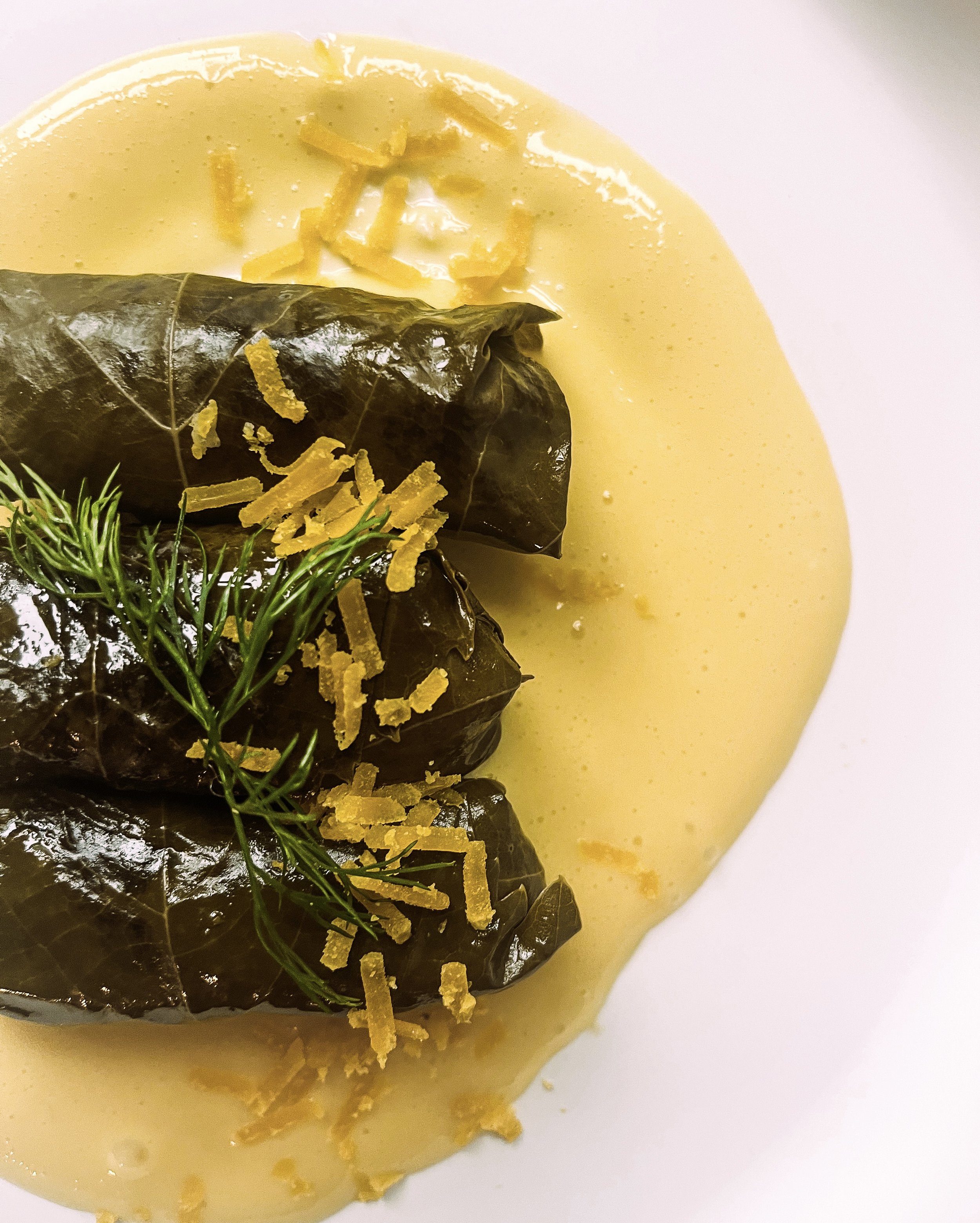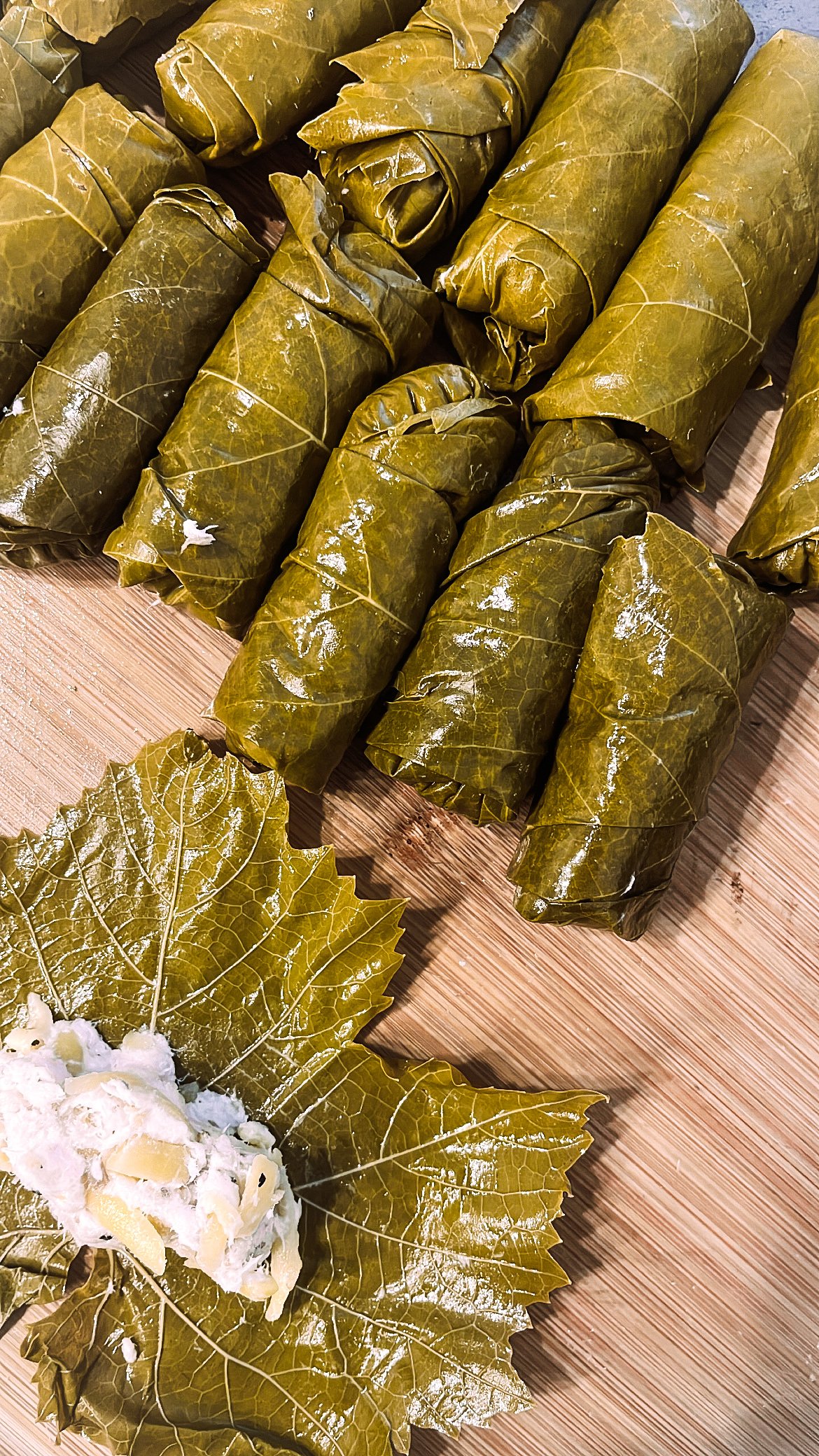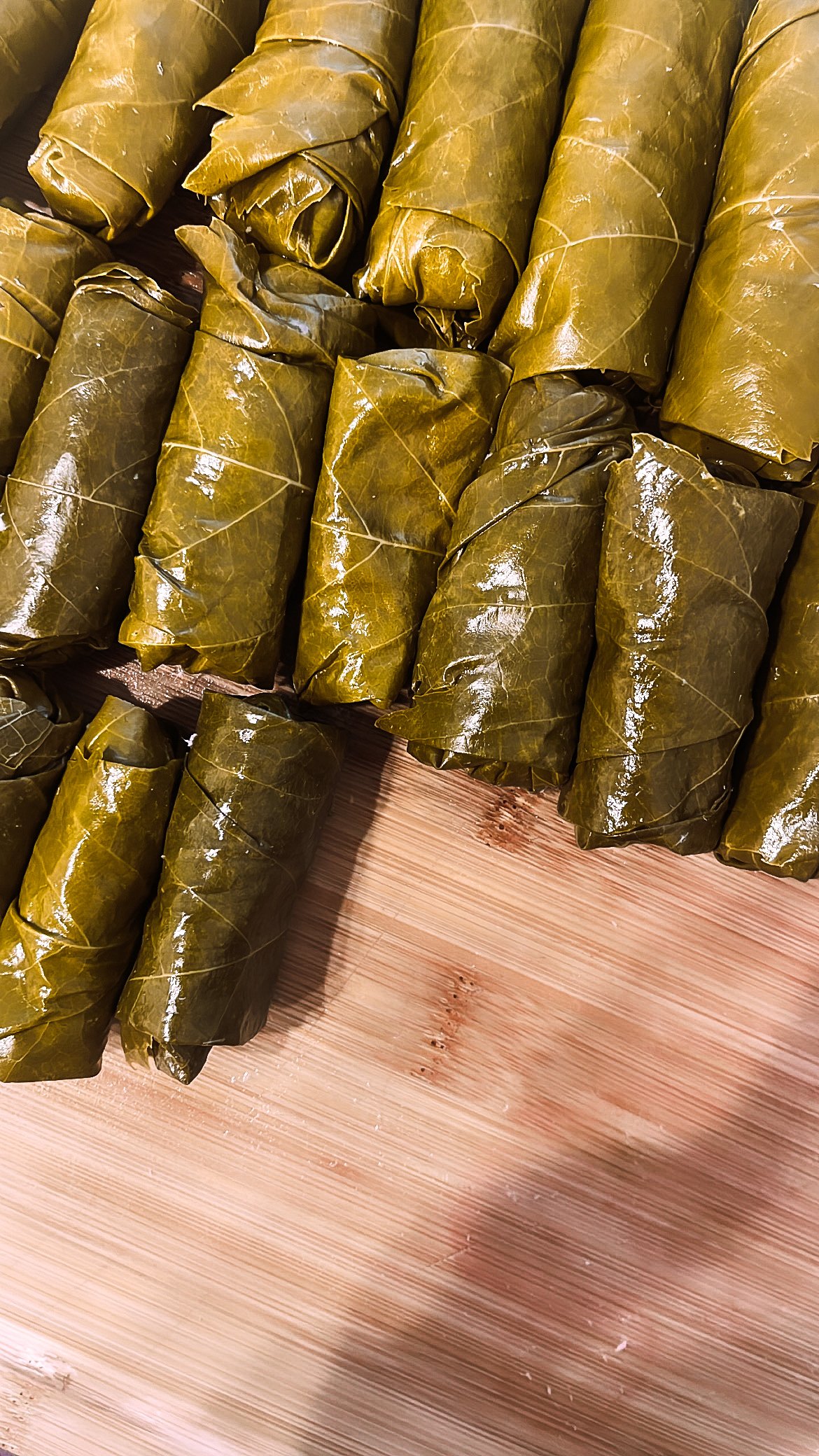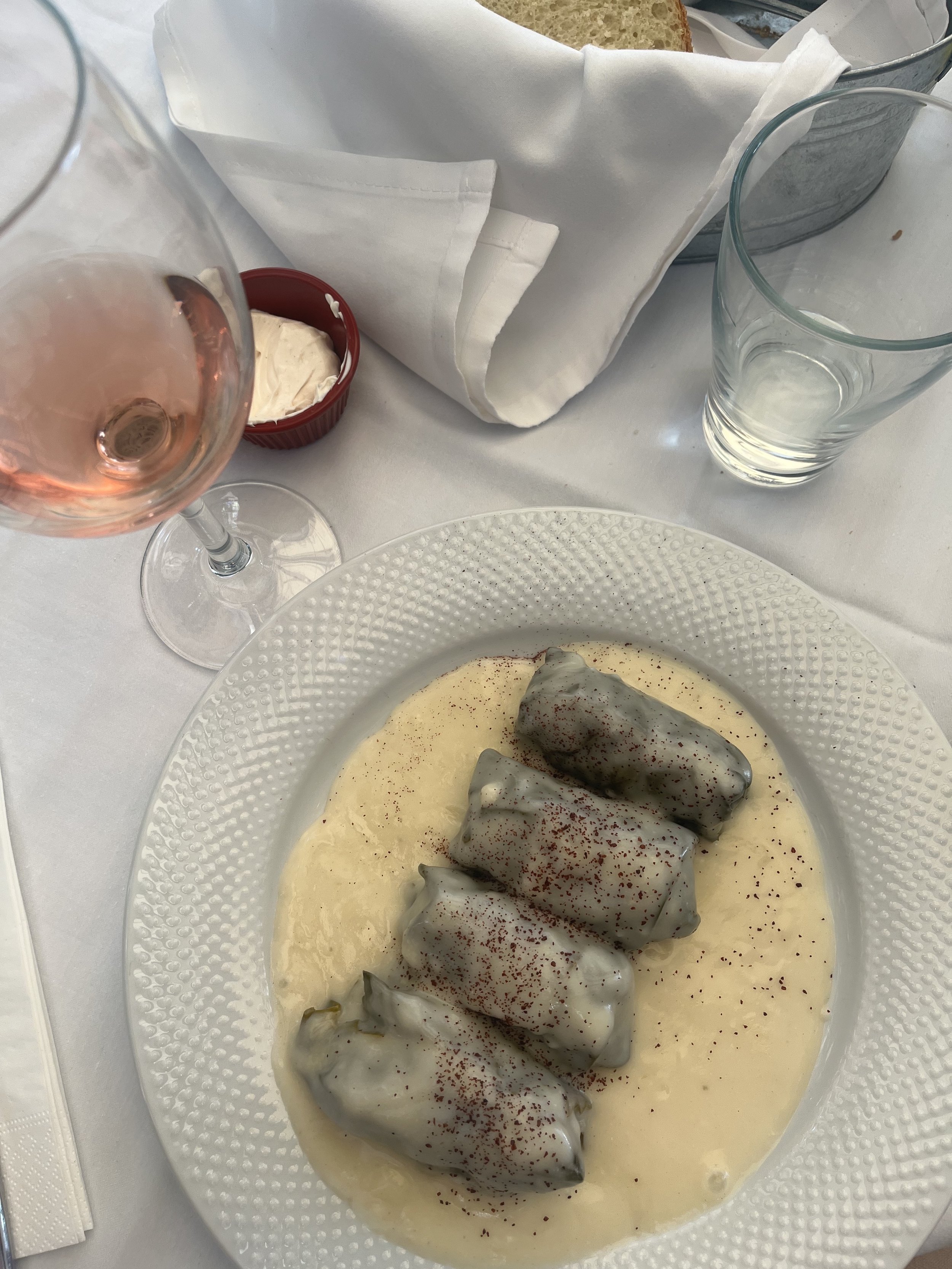Smoked Whitefish Rolled Grapeleaves + Avgolemono Sauce
Lebanese-style grape leaves have watched me grow up just as I’ve grown up eating them.
From my dad teaching me how to make them in Nashville, Tennessee, to eating them when we’d make a roadtrip pit-stop at my great-grandma’s house in Clarksdale, Mississippi, to rolling what always seems like an infinite number of them with my brothers at Christmas time, and now to making them in my Chicago apartment because I’m missing home—rolled grape leaves have practically raised me. The ones I grew up with, however, are not like the ones in this recipe. The ones I’ve grown up getting back aches from standing so long while rolling them are simple: stuffed with meat and rice, and that’s about it. They don’t need a fancy sauce or grated cured egg yolk to make them special, they just are, at least to me.
That being said, I’ve been wanting to play around with some fun variations of my beloved grape leaves for quite some time now, and a spontaneous morning spent at Chicago’s Green City Farmer’s Market fully inspired this unconventional version I’m sharing with you today.
I passed by a fish stand and was drawn to their smoked whitefish. I immediately thought about the distinct sour-salty pickled flavor of grape leaves and how amazing it would pair with smoked fish. I was sold. Then began my hunt for a starchy component to add to the filling. I thought about rye berries to go with the Nordic influence of the fish, but I felt like a sturdy grain would be too heavy with something so delicate. I ventured through the rest of the stands, and some small-ish Irish Cobbler potatoes caught my eye. Sold, once again. My final purchases were one bunch of dill, an absurd number of lemons, and some local Goat butter.
I just so happened to have cured some egg yolks a few days prior, and since I lack self-control, I grated them on top. Thank God I did, though, because the cured egg yolk is 100-percent a necessity. Alone, the grape leaves are good — the most potent note is definitely a smoky char from the fish. With the avgolemono sauce, the grape leaves are better, but tart. With that final touch of fresh dill and the salty-fatty grated egg yolk, they’re absolutely unmissable. All of the ingredients balance out so nicely and turn something that you might only be able to enjoy one or two of into something that might have you duct-taping your fridge shut to keep yourself out of in the middle of the night.
Now, let’s talk avgolemono.
My mom has made avegolemono soup a few times, which is essentially a Greek egg drop soup — made up of lots of eggs and lemons, just like the sauce. I wasn’t introduced to the sauce until I was in Athens, Greece this past spring. I very quickly became acquainted with the Greek custom for dolmas, and while they don’t stand a chance against the Lebanese version (I’m very, very biased), they’re pretty dang good. Rather than small, tight cigarettes filled with beef and rice, Greek dolmas are large, often filled with lamb, and covered in avgolemono sauce. I love pickled, tart, and smoky flavors together, so I thought the richness of the avgolemono sauce would add both a fatty and creamy component, as well as a much needed tang.
Though this whitefish version won’t be replacing the kind I grew up with anytime soon, there is one thing about this recipe that trumps the traditional one. The biggest worry with Lebanese grape leaves is keeping them moist and flavorful. The rice soaks up so much liquid and the beef loses so much juice through the cooking process that the final product can easily become dry and bland, no matter how much lemon you squeeze over them or sticks of butter you add. With this version, however, the smoked fish leaves little room for water loss. On top of that, the potatoes take much less water to cook than rice, which results in some insanely juicy, tender, and flavorful grape leaves. So flavorful that it’s been over 24 hours since I made them, and I’m still smacked in the face with the smell of them every time I walk into my kitchen (definitely not complaining about it).
The best part about this whole recipe? Just like traditional grape leaves, they only get better with time. Good luck trying to save them for longer than a week, though — like I said earlier, duct-tape might really come in handy.
Smoked Whitefish and Potato Rolled Grape Leaves with Avgolemono + Cured Egg Yolk
For the cured egg yolk:
egg yolks, however many you want to cure
1:1 ratio course kosher salt and granulated sugar
Evenly combine the sugar and salt together in a bowl. I used a plastic tupperware container to cure my eggs, but you can use any sort of closed container or vessel (a baking sheet will also work). Spread a thick and even layer of the sugar/salt mixture in the container. Form little wells about the size of an egg yolk, for however many yolks you have, ensuring the bottom of the well is still completely covered in the mixture (you don’t want any shallow surfaces). Separate the eggs and gently drop each yolk into a divot. Carefully, cover completely with enough sugar/salt mixure to create another thick layer. Cover and place in the refrigerator for 2 days. Gently uncover each yolk and flip them over (they should be firm enough to handle at this point. Recover and place in the fridge again for another 2 days. Remove from the container and carefully rinse off the yolk while removing the membrane (you might not see it, but it’s there - just feel around the yolk until you feel something you can pull off and — gently — remove it.
Turn your oven on the lowest possible baking setting. Pat each yolk dry, place on a baking or dehydrator tray and dehydrate in the oven until completely firm and dried (about 45 minuetes to an hour, depending on your oven’s lowest setting - mine took 45 minutes at 170ºF).
Save in an airtight container in the refrigerator — grate over salads, pasta, avocado toast, grits, or these grape leaves.
For the grape leaves:
1 jar pickled grape leaves
2 cups smoked whitefish, flaked
1 cup worth shredded white or gold potatoes, I used 6 small Irish Cobbler potatoes
1 lemon, zest + juice
2 tsp. dried oregano
1 tbs. dill, finely minced
1 tsp. each salt and black pepper
1/2 stick (4 tbs.) unsalted butter
2 garlic cloves, finely minced
2 additional lemons for juicing
olive oil
Lay the grape leaves on a paper towel to lightly dry while preparing the mixture (no need to separate individually, just rest the bundles of grape leaves on paper towels how it comes out of the jar).
Wash and scrub potatoes. Add the potatotes — with skin on — to a pot of salted water, enough to cover them fully. Bring potatoes to a boil and leave until par-cooked halfway. Allow to cool before removing peel.
In a bowl, flake the smoked whitefish and remove any loose bones. Grate 1 cup worth of the potatoes into the mixture, the way you would grate hashbrowns. Season with salt, pepper, oregano, lemon juice and zest from 1 lemon, and minced garlic. Chop the butter into very small dices, add to the bowl, and use a fork to mash the mixture together until fully combined and creamy. You don’t want to see any big chunks of fish.
Line a deep pot with a layer of grape leaves on the bottom surface. To roll the grape leaves, lay each leaf flat, place a small amount of filling (about 1-2 tbs. depending on the size of each grape leaf) in the bottom center of the leaf and form it into a log. Roll the sides over first, and then begin to roll the mixture into the leaf to create a thick cigarette shape, tucking in the sides as you roll. Traditionally, you don’t want to roll them too tight since they usually require room for rice to cook, but since these don’t have rice, you can roll them tight. Make sure the leaf entirely encases the filling. If a leaf breaks, use a new one.
Place each rolled grape leaf into the pot, forming a flat layer, and then forming a second layer stacked on top going in the opposite direction. Repeat until all grape leaves are done, remembering to alternate directions for layers. Squeeze the juice of 2 lemons over all of the leaves, drizzle with a generous amount of olive oil, and add about 1 inch of water to the bottom of the pot. Cover with more flat grape leaves to enclose. Throw the squeezed lemons on top and cover the pot. Steam over low heat for 35-45 minutes, until the grape leaves are tender and the potato is fully cooked inside. Remove from heat, keep covered, and allow to cool. While cooking, prepare the sauce:
For the avgolemono sauce:
3 eggs + 1 egg yolk
2 lemons, juice
1 tsp. salt
about 3 cups warm stock (chicken or vegetable works best - water will suffice) - not boiling, just above luke warm
Traditionally, avgolemono sauce is an equal egg to lemon ratio, however with the high lemon-concentration in these grape leaves, I like adding more egg and salt to this recipe to create a milder sauce.
Whisk the eggs + yolk together well and add the lemon juice. Ladle a little bit of warm stock while whisking eggs vigorously to keep from scrambling. Continue to add enough to bring the temperature of the eggs to the temperatture of the stock and create about 3 cups worht of a sauce. Pour into a saucepan over low heat and whisk until thickened, similar to a hollandaise sauce. Season with salt and set aside to cool completely, whisking occasionally to keep from curdling/forming a skin. This is best served room temp or chilled with the grapeleaves.
To plate, spread a layer of the sauce first, place grape leaves on top, and garnish with grated cured egg yolk and fresh dill.
Dolmas with Avgolemono I ate in Athens, still dreaming about them.






